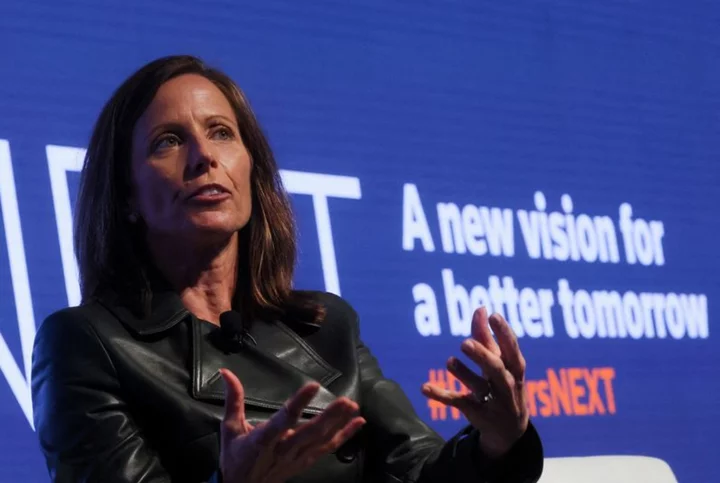By John McCrank
NEW YORK Nasdaq's eye-popping $10.5 billion bet on the little known financial software company Adenza will help the exchange operator vastly expand the market for its products, from risk management and regulatory software to anti-financial crime technology. Nasdaq said on June 12 it would buy Adenza from private equity firm Thoma Bravo, and its stock sank over 10% that day as investors reeled from sticker shock. Nasdaq shares are currently down around 12% since the deal was announced.
However, some experts including a major Nasdaq investor and two sources familiar with the deal said in interviews the acquisition was in line with Chief Executive Adena Friedman’s push to transform Nasdaq into a financial technology company and the price might eventually prove justified.
By one metric, Nasdaq paid around what Thoma Bravo spent on creating Adenza through the merger of two software firms, the sources familiar with the deal said. Nasdaq also hopes to cut overlapping costs, which would boost profitability and make the deal look cheaper, one of the sources said. As part of Nasdaq, Adenza would get access to new banking clients in the United States and Europe as well, allowing it to drive revenues more than it could on its own, analysts said.
With Adenza, Nasdaq's recurring revenues, which investors like for their predictability, will comprise around 77% of overall revenues, up from 71%. As Nasdaq's recurring revenues have increased, so too has its valuation, which went from one of the lowest in the exchange sector prior to 2017 when Friedman took over, to one of the highest now, said Rosenblatt Securities analyst Andrew Bond.
"This acquisition doesn't veer off from Nasdaq's strategy or what Adena's been pursuing since she's been the CEO," Bond said. "The cross-sell opportunities are significant."
Still, analysts said the upfront price is steep and the deal is risky. Nasdaq, which had a market cap of around $28 billion before the deal was announced, is paying for the acquisition with a roughly even split of stock and cash. That dilutes existing shareholders and increases its debt load. Moody's downgraded Nasdaq's debt to BBB from BBB+ on the deal.
"It does seem like they're buying a high-quality asset but ultimately they're paying a pretty high price," Morningstar analyst Michael Miller said.
Nasdaq said it believes it is paying an appropriate price.
MOVING TO FINTECH
Nasdaq and many of its peers have been morphing into financial technology firms, largely through deals, as regulatory and nationalist pushback effectively killed big cross-border exchange mergers, and as trading volumes fell after the 2008-2009 financial crisis, stunting transaction-based revenues.
A director at one of Nasdaq's largest shareholders, whose firm supports the Adenza deal, said there were few good companies left that could be synergistic to Nasdaq. Adenza was one of the largest, with a compound annual growth rate of 15% and a profit margin above 50%.
The acquisition "diversifies and stabilizes the sources of the revenue," the shareholder said.
Nasdaq is paying around 31 times earnings before interest, taxes, depreciation and amortization (EBITDA) for Adenza. The sources close to the deal said that is in line with what Thoma Bravo paid combined for regulatory software firm AxiomSL and financial software maker Calypso, which it merged into Adenza.
Between July and December last year, Thoma Bravo cut $30 million of costs out of Adenza, mostly consisting of overlapping positions and real estate. One of the sources said once Nasdaq also cuts out costs, the multiple will be closer to the mid-20s. In addition, Nasdaq could squeeze out additional revenue as it has done with previous acquisitions.
Nasdaq, for example, bought Verafin in February 2021 for $2.75 billion. Verafin had over 3,500 small and mid-sized banks and credit unions using its cloud-based platform to help detect, investigate, and report money laundering and financial fraud. In April, Nasdaq said it signed up its first big tier-1 bank with more than $1 trillion in assets, for the product, and said that win would make it easier to sign up other big banks.
Nasdaq will find cross-selling opportunities in Adenza's stable of bank clients, analysts said. They said clients for Adenza's Calypso offering include tier 3 banks with under $10 billion in assets and tier 2 banks with $10 billion to $100 billion in assets. Its AxiomSL products are aimed at tier 1 banks, especially in Europe, which have assets of $100 billion or more, analysts said.
(Reporting by John McCrank; Editing by Paritosh Bansal and David Gregorio)

